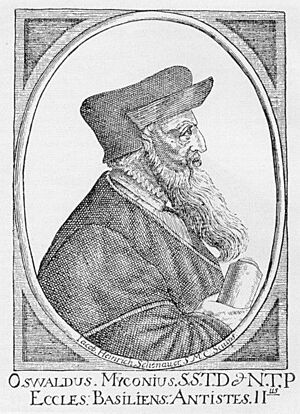Oswald Myconius facts for kids
Oswald Myconius (born in 1488, died in 1552) was an important Swiss Protestant reformer and theologian. He was a close follower of Huldrych Zwingli, another key leader in the Protestant Reformation. Myconius helped to spread new ideas about Christianity in Switzerland during a time of big changes.
A Life of Learning and Change
Oswald Myconius was born in Lucerne, Switzerland. His family name was Geisshüsler. His father was a miller, so Oswald was sometimes called Molitoris, which means "miller" in Latin. The famous scholar Erasmus is said to have given him the name Myconius.
Oswald went to school in Lucerne and then studied classic subjects at the University of Basel. From 1514, he worked as a teacher in Basel. There, he met Erasmus and the famous painter Hans Holbein.
In 1516, Myconius became a schoolmaster in Zürich. By 1518, he joined the group of people who wanted to reform the church. This group was led by Huldrych Zwingli. Because of his support for these new ideas, he was moved to Lucerne. Later, in 1523, he was able to return to Zürich.
After Zwingli died in 1531, Myconius moved back to Basel. There, he became a preacher for the town. He also taught about the New Testament at the university until 1541. In 1534, he wrote an important document called the Confession of Basel. This document explained the beliefs of the reformers in Basel.
Myconius believed that all Protestants should try to work together. Even though he followed Zwingli's ideas, he was willing to find common ground with other groups. This sometimes caused disagreements with those who held very strict Zwinglian views. He died in Basel.
His Writings
Oswald Myconius wrote several books and papers. His most important work is called De H Zwinglii vita et obitu (1536). This book tells the story of Zwingli's life and death. It was later translated into English in 1561 by Henry Bennet.


